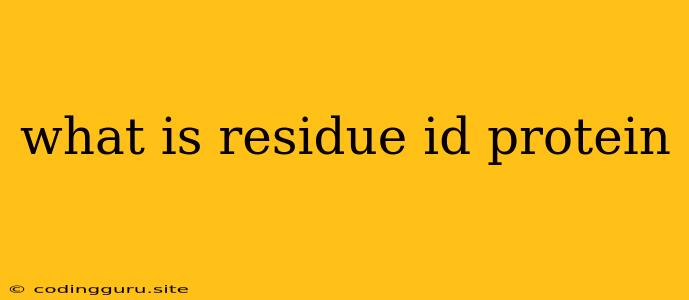What is Residue ID in Protein?
Understanding residue ID is crucial for comprehending the structure and function of proteins. While the term might sound complex, it's a simple concept that helps us identify and analyze individual amino acids within a protein sequence.
What is a Residue?
Before we dive into residue ID, let's clarify what a residue is. In protein chemistry, a residue refers to an amino acid that forms part of a protein chain. Think of it like a building block in a structure. Each residue contributes to the overall shape and function of the protein.
Residue ID: A Unique Identifier
Residue ID, also known as residue number or residue index, is a unique identifier assigned to each residue within a protein sequence. This number serves as a convenient way to locate and reference specific amino acids. It's similar to how we use street addresses to find specific houses within a city.
How is Residue ID Determined?
Residue ID is typically determined based on the order of amino acids within a protein chain. The first amino acid in the chain receives the ID '1', the second '2', and so on. This numbering system allows researchers to easily pinpoint specific residues within a protein, regardless of its overall length.
Why is Residue ID Important?
Residue ID plays a vital role in protein research and analysis for several reasons:
- Structure Prediction: By studying residue ID patterns, researchers can predict the three-dimensional structure of proteins. This helps understand how proteins fold and interact with other molecules.
- Mutation Analysis: Identifying the residue ID of a specific amino acid enables researchers to study the effects of mutations on protein function.
- Drug Discovery: Residue ID is critical in the development of drugs that target specific proteins. Knowing the location of key residues within a protein allows researchers to design drugs that bind to those specific sites.
Examples of Residue ID
Let's consider a simple example:
Protein Sequence: Gly-Ala-Ser-Thr-Val
In this short protein sequence, the residues are:
- Residue ID 1: Glycine (Gly)
- Residue ID 2: Alanine (Ala)
- Residue ID 3: Serine (Ser)
- Residue ID 4: Threonine (Thr)
- Residue ID 5: Valine (Val)
Tools for Analyzing Residue ID
Various tools are available to analyze residue ID and gain insights into protein structure and function. Some popular options include:
- Protein Data Bank (PDB): A massive repository of protein structures, often with residue ID information included.
- Swiss-Prot: A curated database of protein sequences and annotations, often containing residue ID details.
- BLAST: A tool for comparing protein sequences, which can reveal similarities and differences in residue ID.
Conclusion
Residue ID is a crucial concept in protein research and analysis. It provides a unique identifier for each amino acid within a protein chain, allowing researchers to pinpoint specific residues, study their roles, and develop new insights into protein structure and function. By understanding residue ID, we can unlock new possibilities for drug discovery, disease treatment, and fundamental scientific understanding.
